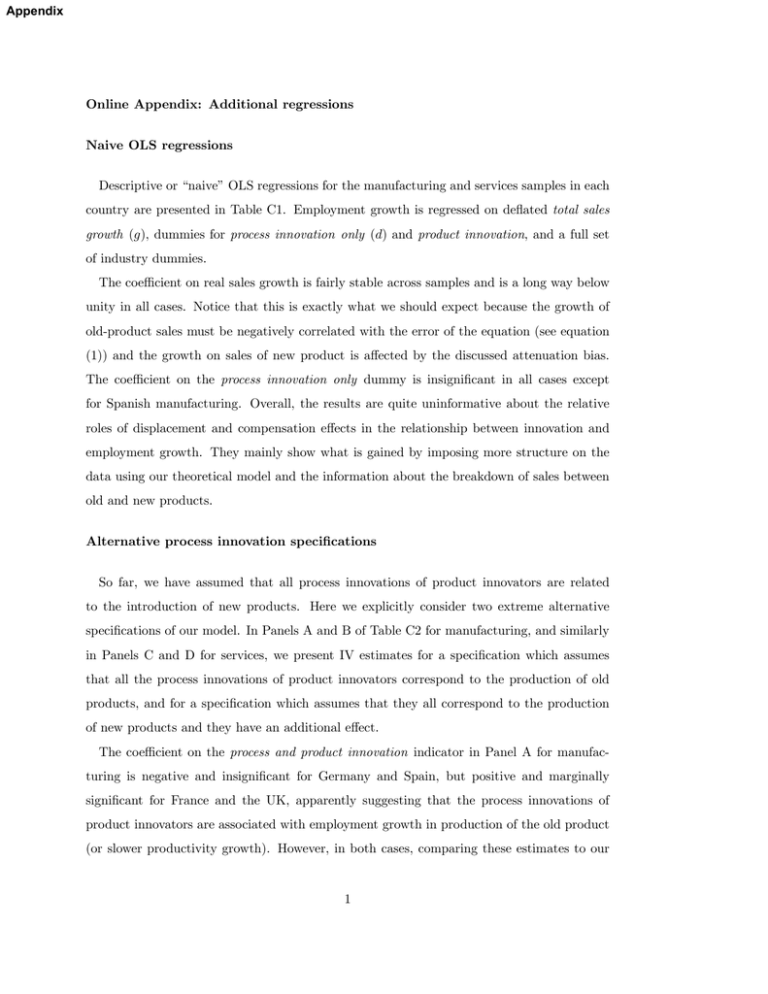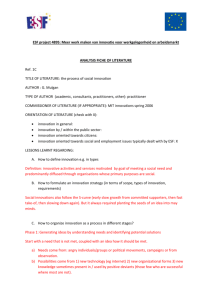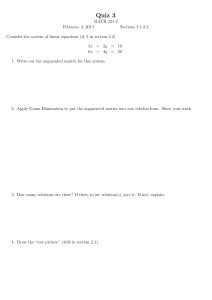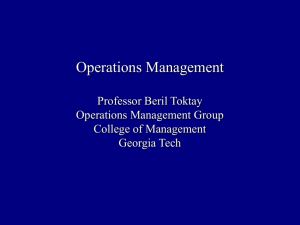Online Appendix: Additional regressions Naive OLS regressions Appendix
advertisement

Appendix Online Appendix: Additional regressions Naive OLS regressions Descriptive or “naive” OLS regressions for the manufacturing and services samples in each country are presented in Table C1. Employment growth is regressed on deflated total sales growth (), dummies for process innovation only () and product innovation, and a full set of industry dummies. The coefficient on real sales growth is fairly stable across samples and is a long way below unity in all cases. Notice that this is exactly what we should expect because the growth of old-product sales must be negatively correlated with the error of the equation (see equation (1)) and the growth on sales of new product is affected by the discussed attenuation bias. The coefficient on the process innovation only dummy is insignificant in all cases except for Spanish manufacturing. Overall, the results are quite uninformative about the relative roles of displacement and compensation effects in the relationship between innovation and employment growth. They mainly show what is gained by imposing more structure on the data using our theoretical model and the information about the breakdown of sales between old and new products. Alternative process innovation specifications So far, we have assumed that all process innovations of product innovators are related to the introduction of new products. Here we explicitly consider two extreme alternative specifications of our model. In Panels A and B of Table C2 for manufacturing, and similarly in Panels C and D for services, we present IV estimates for a specification which assumes that all the process innovations of product innovators correspond to the production of old products, and for a specification which assumes that they all correspond to the production of new products and they have an additional effect. The coefficient on the process and product innovation indicator in Panel A for manufacturing is negative and insignificant for Germany and Spain, but positive and marginally significant for France and the UK, apparently suggesting that the process innovations of product innovators are associated with employment growth in production of the old product (or slower productivity growth). However, in both cases, comparing these estimates to our 1 previous ones (in Panel B of Table 3 in the main text), we see that, while the coefficient on the process innovation only indicator remains unchanged, the coefficient on sales growth due to new products is slightly reduced from about 1.0 to about 0.9, suggesting lower employment growth associated with production of the new product. The results in Panel C for services are unchanged from previously, the coefficient for the product and process innovation indicator being insignificant in all four countries. The alternative hypothesis that process innovations of product innovators are, in fact, associated with production of new products is tested in Panels B and D by including a variable interacting a process innovation indicator with the sales growth due to new products variable. This allows the average relative productivity in production of the old and the new products to be different for firms that also introduce process innovations. In this case, as an additional instrument, we use the existing increased range instrument interacted with the process innovation dummy. For manufacturing, the estimates give insignificant negative coefficients on the interacted variable for Germany and Spain, and positive and marginally significant coefficients for France and the UK, suggesting that new products are associated with some productivity decreases for the firms that also introduce process innovations. For services, the coefficients of the interacted variable are insignificant in the four countries. Overall, while it does not make sense that firms introduce separated process innovations for old products which reduce the efficiency of the old products production process, it seems sensible that some firms stress the introduction of process modifications in new products when they imply an apparent loss of production efficiency with respect to the old products. And, in any case, this phenomenon seems to be marginal. Therefore, we conclude that most process innovations of product innovators should be associated with the introduction of new products and, for this reason, we think that our preferred specification of Table 3 in the main text can do a good job in accounting for the basic facts. Other regressions We have also carried out further sensitivity analysis taking advantage of the availability of a given variable, sometimes for a single country. These are variables not included in the core CIS3 questionnaire, but added by the relevant statistical agencies in individual countries. First, in all countries we include the ratio of physical investment to the value of the sales 2 at the beginning of the period (in 1998) as an explanatory variable. Introducing this variable may control for the role of investment in the subsequent growth of employment. It can also be interpreted as an indirect check on the assumption of no changes in relative factor prices. In the case of a change in factor prices, this variable would tend to be significant. We find that the variable is significant for some regressions but the coefficients on process innovation only and sales growth due to new products are not significantly affected. Second, we introduce a variable specific to the German data indicating whether firm process innovations are associated with rationalisation (cost reduction). The results suggest that these cost-reducing process innovations are particularly focused on reducing employment requirements (see Peters, 2004, for more details). Third, we check whether the growth in employment over the observed period might be measuring only a fraction of the total effect of innovation, with the remaining effect taking place after the end of the period. To test for this possibility, we included a variable from the Spanish data specifying what firms expect the change in their level of employment to be over the coming two years. The coefficient on expected employment growth is negative but insignificant, suggesting that we are not missing important dynamic effects in our preferred specification. Finally, firms in the UK are asked separately about the proportion of their sales in 2000 that are accounted for by “significantly improved” and by “new products” stricto sensu, whereas firms in other countries are only asked about the proportion accounted for by “new or significantly improved” products. This allows us to test whether our results would be significantly different if “new products” stricto sensu were distinguished from products that are merely significantly improved. In fact, our results remain practically unchanged. 3 Table C1. Exploratory OLS regressions: employment growth on sales growth and innovation dummies1 Dependent variable: Sector FR Manufacturing DE SP UK FR DE Services SP UK Explanatory variables Constant 2.52 (0.53) -2.21 (0.74) 6.59 (0.59) -0.62 (0.62) 5.15 (2.23) 2.71 (1.87) 8.44 (1.67) 6.10 (1.31) Real sales growth () 0.43 (0.02) 0.43 (0.04) 0.35 (0.02) 0.48 (0.03) 0.45 (0.04) 0.49 (0.04) 0.48 (0.03) 0.46 (0.03) Process innovation only () -0.54 (1.17) -0.49 (1.20) 2.98 (1.25) -0.29 (1.56) -3.78 (2.73) -0.12 (1.97) 0.57 (2.60) 3.68 (3.29) Product innovation2 1.11 (0.72) 3.99 (1.21) 2.0 (0.88) 2.29 (1.28) 3.30 (2.74) 3.94 (1.85) 2.82 (2.31) 5.57 (2.05) N of firms Standard error 4631 21.64 1319 19.31 4548 26.10 2533 24.27 1653 39.33 849 23.50 1839 36.09 1794 30.13 1 Coefficients and standard errors robust to heteroskedasticity. All regressions include industry dummies. 2 Product innovators only and product and process innovators dummy. Table C2. Alternative assumptions about process innovations Dependent variable: − 1 Sector Manufacturing A (IV2 ) Regression Services B(IV3 ) C (IV2 ) D (IV3 ) FR DE SP UK FR DE SP UK FR DE SP UK FR DE SP UK Constant -3.51 (0.78) -6.96 (1.37) -6.14 (0.91) -6.33 (0.88) -3.50 (0.78) -6.97 (1.37) -6.12 (0.90) -6.24 (0.84) -4.96 (2.44) -3.39 (3.04) -3.82 (2.20) -5.45 (1.62) -5.24 (2.48) -3.23 (3.05) -4.07 (2.24) -5.61 (1.62) Process innovation only () -1.26 (1.56) -6.20 (2.92) 2.47 (1.79) -3.50 (1.85) -1.32 (1.57) -6.18 (2.92) 2.47 (1.78) -3.54 (1.85) -1.63 (3.47) 1.56 (3.06) -0.46 (3.36) 3.10 (3.53) -1.45 (3.47) 1.46 (3.07) -0.32 (3.37) 3.25 (3.53) Process & product innovation 2.59 (1.43) -1.98 (2.80) -1.49 (2.64) 4.94 (2.56) -3.81 (5.55) 1.80 (4.26) -6.52 (6.72) -6.26 (4.96) Sales growth d.t. new products (2 ) 0.90 (0.09) 1.04 (0.07) 1.05 (0.07) 0.92 (0.07) 1.23 (0.18) 0.90 (0.11) 1.07 (0.14) 1.10 (0.09) 1.18 (0.17) 0.86 (0.11) 1.13 (0.12) 1.10 (0.10) -0.04 (0.20) 0.09 (0.10) -0.23 (0.12) -0.10 (0.11) 45.11 1653 33.76 849 43.25 1839 38.07 1794 Sales growth d.t. new products × process innov. 0.90 (0.09) 1.03 (0.08) 1.03 (0.06) 0.91 (0.07) 0.14 (0.08) -0.04 (0.07) -0.02 (0.06) 0.14 (0.08) Standard error 28.07 27.46 36.35 30.13 28.20 27.27 36.26 30.19 45.36 33.53 N of firms 4631 1319 4548 2533 4631 1319 4548 2533 1653 849 1 Coefficients and standard errors robust to heteroskedasticity. All regressions include industry dummies. 2 Unique instrument used is increased range. 3 Instruments are increased range and increased range interacted with process innovation. 43.51 1839 38.19 1794





